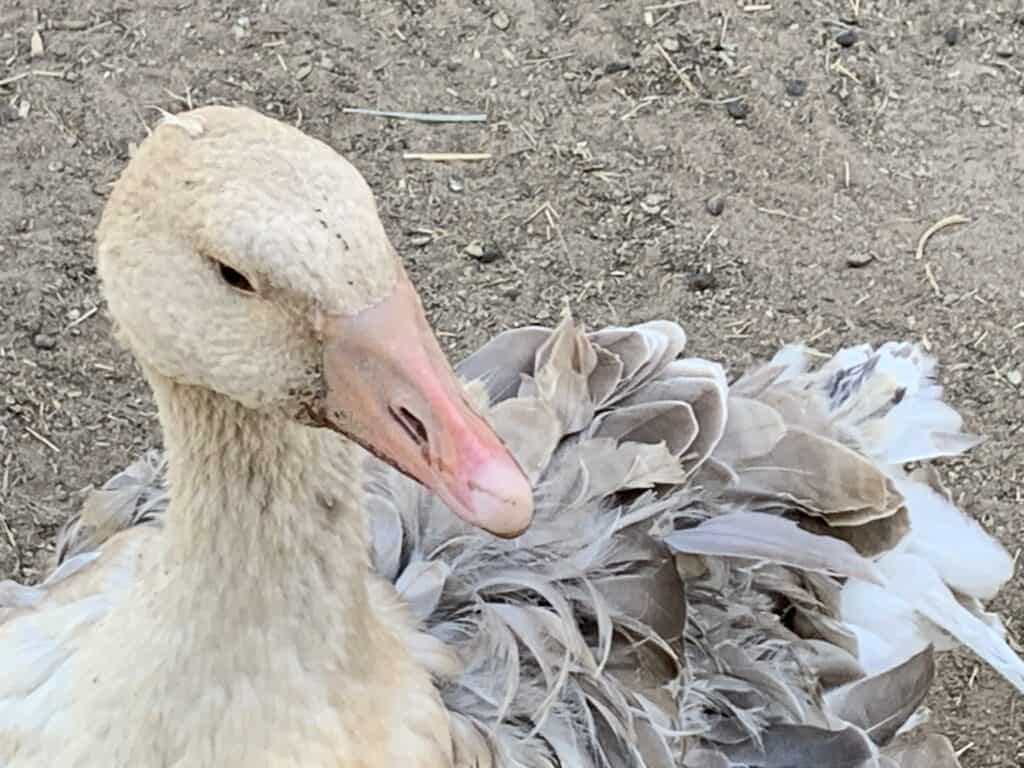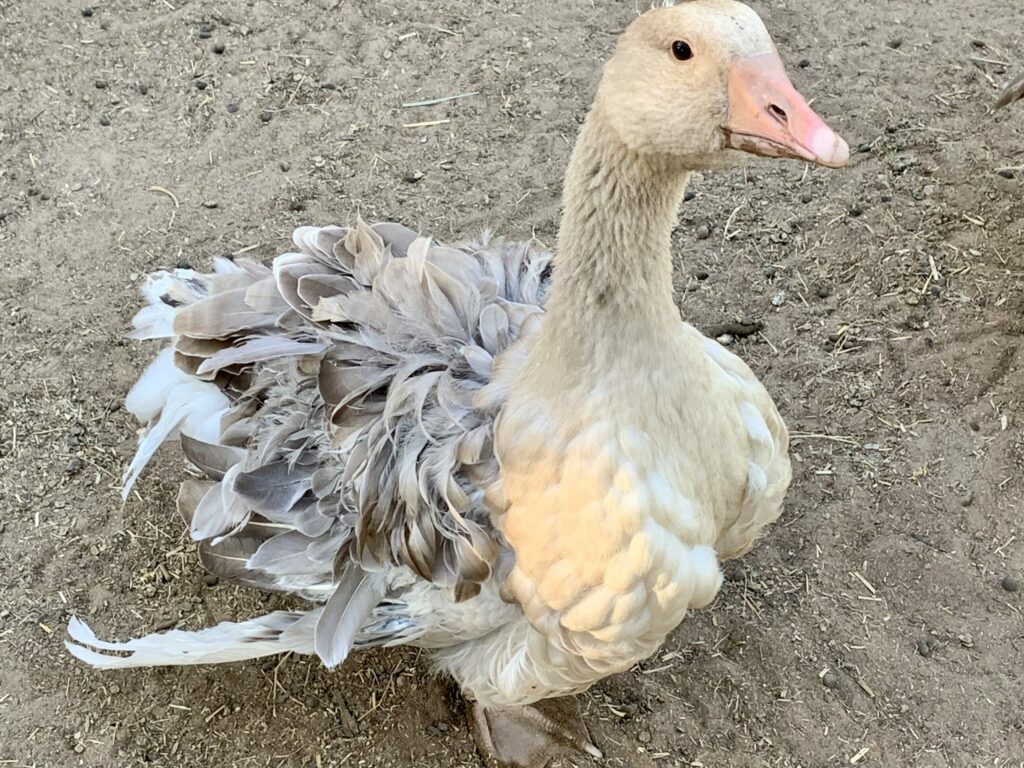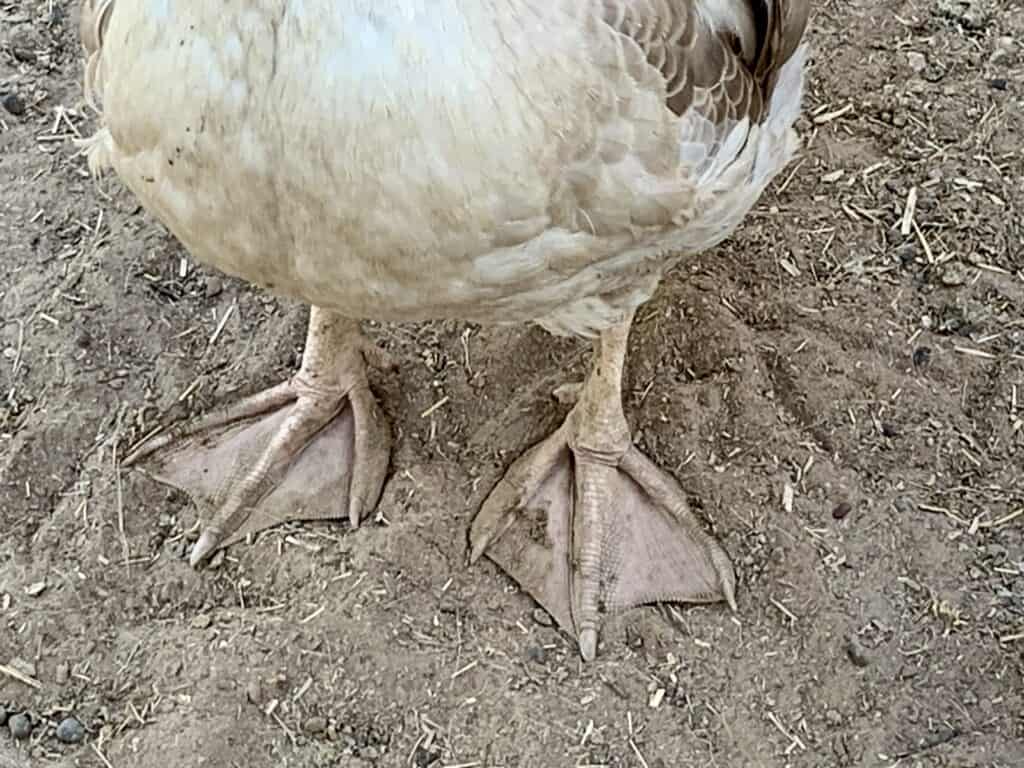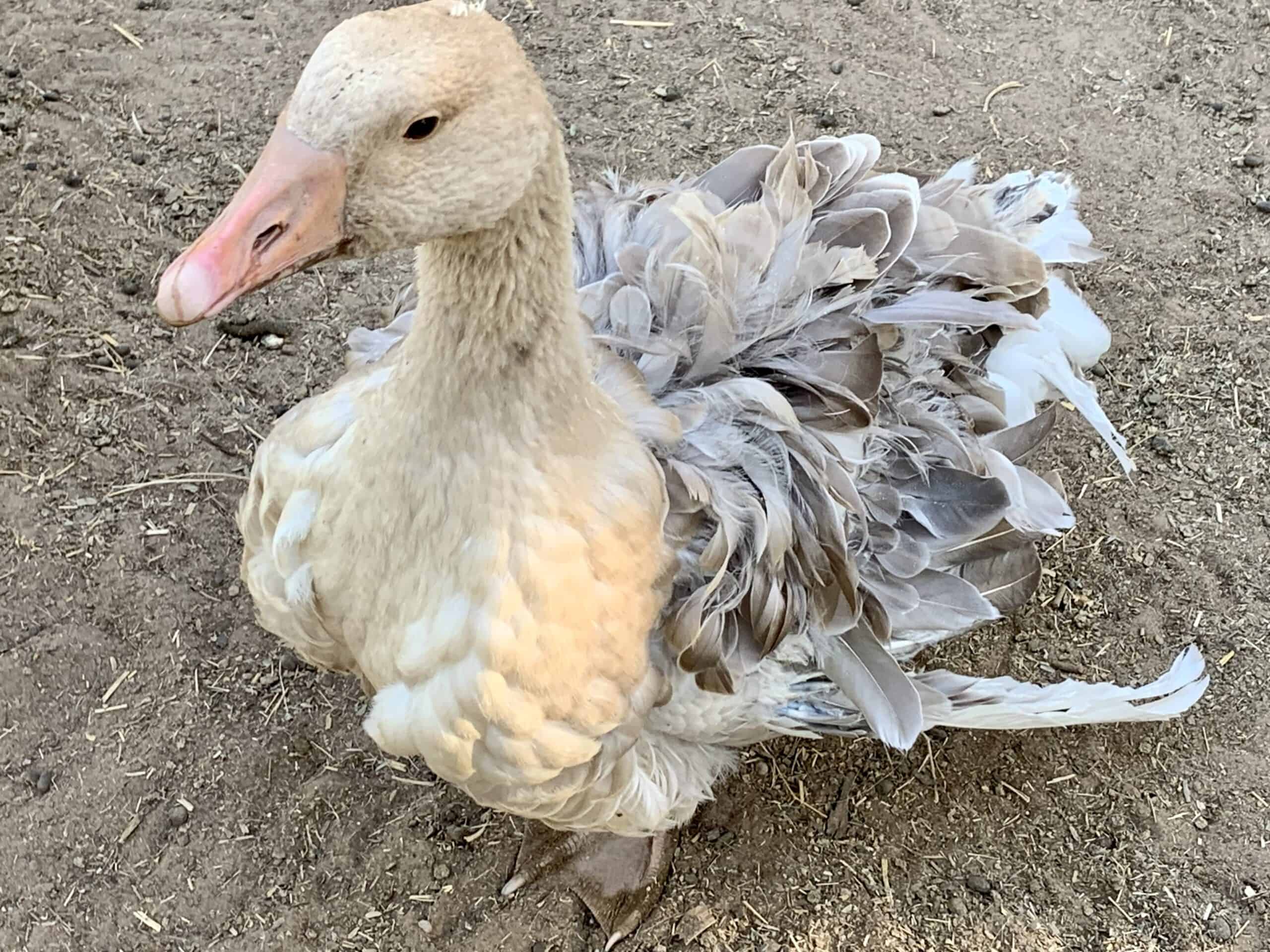Sebastopol geese are a domesticated, medium-sized breed. They are very social and do well in a flock. Depending on your needs, they may be a good addition to your farm or homestead.
Known for their unique, curled feathers — I think they look like a skirt on the geese — they stand out as an elegant option for exhibitions, as pets, and for weed control.
They have attributes not typically found in all breeds of geese. Sebastopols are:
- Friendly
- Have a quiet disposition
- Are hardy
- Acclimate well in colder climates
In addition, like most domestic geese, they can’t fly well. This is due to the Sebastopol goose’s curled feathers. Impeded flight means less work in confining these birds and fewer issues with them wandering into neighboring areas to graze. Most Sebastopols are white. Some pictured here are gray as well.
Laying around 25 large, white eggs annually, they offer modest egg production and are suitable for small-scale meat production. Whether for aesthetics, utility, or companionship, Sebastopol geese’s unique characteristics provide compelling reasons for raising them.
A reason you may not want to raise them as pets is that they live for around 25 years.
The Sebastopol goose has distinct wavy and frizzled feathers that set it apart from other goose breeds. Keep reading to learn more about these inquisitive and friendly geese.
Purpose for Raising Sebastopol Geese
There are several reasons people raise Sebastopol geese. Whether you’re a hobby farmer looking to maintain a garden and yard or someone interested in ornamental pets, these geese offer some practical uses for homesteaders.
1. Ornamental and show purposes
Due to their elegant, curling feathers, Sebastopol geese are often prized for their aesthetic appeal. Their unique feathering makes them a popular choice for ornamental display and for exhibition. They are a sight to behold!
2. Lawn maintenance
Excellent foragers, a pair or small flock of Sebastopol geese can be used to keep the grass short and weed a hobby garden.
3. Meat production
Though not used commercially for meat, these geese fatten easily and can be raised for personal meat needs. They are known for good quality roasting meat.
It’s important to cull them when they are 6 – 10 weeks old to align with pre-molting phase. This makes it easier so you don’t have to remove the pin feathers. This means there is less cost with feeding them compared to other geese which are may be ready for slaughter when they are 10 – 20 weeks old.

4. Egg laying
If you are considering raising Sebastopols for eggs, it’s important to recognize their egg yield will be lower than what you might expect from typical backyard poultry. Chickens and ducks are better if you are looking for egg production.
Female Sebastopol geese lay an average of 25 to 35 eggs each year. Their eggs are large and white. Their eggs can weigh up to 7 oz each. Each typically compare to 3 – 4 chicken eggs. They typically lay from early spring into summer.
Even though their eggs are large, this is a small amount of eggs each year. You wouldn’t want to raise Sebastopol geese if you are looking for a source of eggs solely. Though they can be a worthwhile addition for those interested in diversifying their egg production.
The females are maternal and go broody. They caring mothers and will act as adoptive parents to other goslings.
5. As pets
Their friendly and reserved nature, rather than aggression, makes them suitable as pets on a farm.
6. Educational and community involvement
Sebastopol geese can be a valuable addition to school farms. While they aren’t going to want to be handled like goats or lap chickens, their hardy and gentle nature often makes them an excellent choice for educational purposes.
| Sebastopol Geese Uses | Description |
|---|---|
| Ornamental, Pet, or Show | Major reasons people keep Sebastopol geese |
| Lawn Maintenance | Useful to keep the grass short and weeding gardens |
| Meat | Raised for personal meat needs, known for good roasting quality |
| Eggs | Large white eggs, but limited in number (25 to 35 per year) |
| Friendly Pets | Suitable as farmyard pets; good for schools with farms who want geese |
| Hardy | Easy to raise with good care |
Raising Sebastopol Geese for Meat
Raising Sebastopol geese for meat is not commonly associated with commercial meat production. However, it is doable on a small scale. They can be raised for personal meat needs on hobby farms or on homesteads.
If you’re considering this idea, there are several advantages compared to other geese breeds:
Processing time
Sebastopol geese can be processed for meat when they are 6 – 10 weeks old. Timing is important because this age aligns with the life stage before they molt their juvenile feathers and grow into their adult plumage. Many other breeds are ready for slaughter when they are 4 – 5 months old.
Feather consideration
By slaughtering the geese within this age window, you can avoid the labor-intensive task of pulling pin feathers from the carcass. This makes the processing easier, cleaner, and more straightforward.
Carcass appearance
An additional benefit of raising Sebastopol geese for meat relates to the aesthetic quality of the carcass. Though this is largely a matter of personal preference, the lighter feather color can lead to a cleaner-looking carcass. This might enhance the overall look when it’s ready for cooking.
However, there generally wouldn’t be enough meat to sell for commercial purposes. This is because their carcasses are small. Their meat would typically be limited to personal consumption for family needs on a small scale.

Maternal Instincts and Breeding
Although they are moderate layers, a female Sebastopol goose has strong maternal instincts. They are known for being broody and caring mothers. Another benefit is their ability to act as adoptive parents for goslings of their own breed and other breeds.
Male geese, called ganders, can be mated with 1 – 4 geese, offering flexibility in breeding arrangements.
If there are fertility issues, you can clip the long plumes of the back and tail and the feathers around the vent. This can help with reproductive success.
Breeding Considerations
When breeding Sebastopol geese, The Livestock Conservatory advises to not choose geese or ganders with crooked toes, slipped wings, and other defects. The primary selection criteria includes:
- Robust health
- Adequate size
- Well-curled breast feathers
- Flexible flight feathers
- Long, broad, spiraled back and tail plumes
Hatching Sebastopol Goose Eggs
Sebastopol goose eggs take 28 to 35 days to hatch. The incubation period will depend on factors such as incubation temperature and humidity. The eggs can weigh as much as 7 ounces each.
Female Sebastopols will go broody. They will care for their eggs and their young.
Incubating Sebastopol goose eggs yourself requires careful attention to detail. Ensuring optimal temperature and humidity within the incubator is vital for successful hatching. Maintaining precise conditions leads to healthy goslings. Therefore, continuous monitoring is essential for the incubation process.
Temperament and Behavior
Sebastopol geese have an easy-going temperament and personality. This usually makes them good pets on your property. They can be good for families and individuals inexperienced raising geese.
They are rarely aggressive. Though not as vocal as other geese breeds, Sebastopol geese still have the ability to act as alarm animals. They will honk if something unusual is detected, albeit without broadcasting as far and wide as other breeds.
This quality allows them to offer a sense of security without becoming a nuisance.
Sebastopol geese will likely get along with ducks, chickens, roosters, and goats on your farm. With enough room to roam and explore, and enough food and water, they should get on well.
Flightless Geese
Generally, Sebastopols are mostly flightless birds. It is not their weight that restricts them from flying, but their curled feathers. Their feathers make it impossible for them to get any significant lift.
Because they won’t fly away, they are easier to confine. However, this makes it imperative protect them from predators, especially at night.

Appearance
Sebastopol geese are best identified by their wavy, curling feathers. They are longer than feathers in most other goose breeds. Their feathers are soft-quilled and drape elegantly from the wings, body, and tail. They have a gene that results in their feather shafts being more fragile and flexible than in other geese.
Feathering
They are spiraled and look crinkly. Sometimes they are long enough to almost touch the ground. Their breast feathers can be either smooth or frizzled. Their underbody feathers are elongated and well-curled. The feathers on their backs, wings, and tails are soft, fluffy, and flexible.
Weight
Sebastopol geese are medium-sized birds. Their feathers’ unique texture and size often make it seem like Sebastopols are larger than they actually are. At maturity:
- Males: Ganders weigh up to 12 – 14 pounds
- Females: Geese weigh around 10 – 12 pounds
Color variations
According to The Livestock Conservatory, white is the only Sebastopol color recognized. Their pure white feathers contrast vividly with their bright blue eyes and orange bills and feet. Juveniles often show traces of gray.
Despite the popularity of the white variety, Sebastopol geese also come in other colors such as gray and buff. There are also color crosses that have produced saddleback and all-gray variants. The feathers on the breed’s neck can be grey-brown instead of white.
Physical characteristics
They have rounded heads, slightly arched necks, and keelless breasts. The shanks and legs are orange. Their thighs and shanks are short. They have webbed feet. Typical eye color is blue, especially common in the classic white Sebastopol. However, some color variants may result in geese with brown-colored eyes.
Caring for Sebastopol Geese
Must raise more than one goose
One of the most important aspects of raising Sebastopol geese is that they need companionship. Reputable farms will not sell you only one goose unless you have one already. You must raise more than one goose together. Goslings may not survive without a companion.
Geese thrive better in pairs or, most preferably, in trios consisting of one male and two females. Many farms prioritize the sale of trios or pairs, only selling singles if the buyer already has at least one goose.
Water, food, shelter
Like with all poultry and livestock, basic care requirements include access to fresh, clean water, nutritious food, and shelter to protect them from predators and harsh weather. They are omnivorous and will mostly eat grasses, weeds, and other plants when possible.
Dry in cold weather
In addition, care for Sebastopol geese requires special attention to ensure their well-being, particularly during cold, wet weather. While they are hardy birds that can thrive in cold climates, they need warm and dry shelter during wet and windy conditions.
Unlike other breeds, their loose-fitting feathers don’t provide much warmth or shed water effectively.
Enough space
Like with all animals you raise, they need to have enough space. To maintain the appearance of their long, curled feathers and reduce health problems, avoid overcrowding by keeping them in spacious, clean, dry pens.
In addition, options for them to free range during the day is strongly preferred. The ability to forage in tall grass can help brush themselves clean.
Water buckets or kiddie pools
Providing water buckets for them to submerge their heads can be enough for raising a Sebastopol goose. Instead of full-body bathing, some experts suggest buckets of clean water for them to maintain their cleanliness while keeping their body feathers dry. You can also full a kiddie pool so they can swim.
Healthcare
It’s important to perform health checks on geese. This includes their crop, keel, abdomen, range of motion, and foot, leg, and wing flexibility. Regular head-to-toe evaluations will help you determine if something seems off.
Feeding Geese
Sebastopol geese have a digestive system that can handle high-fiber diets efficiently, thanks to a robust proventriculus and gizzard. They require grit from their environment for digestion.
Initially, goslings should be fed a complete feed, transitioning to grass by two months and relying mostly on quality pasture by four months. In lower-quality pastures, supplemental feed may be necessary.
Foraging Capabilities
These geese excel in foraging, selectively eating clovers, bluegrass, and other succulent grasses while avoiding tougher varieties. This selective feeding makes them natural weed controllers in various crops. An acre of good pasture can support 20+ geese, depending on pasture quality.
Feed Considerations
Specific goose feeds are rare. You should start goslings on a chick starter, then transition them to a pelleted grower diet supplemented with cracked grains after a few weeks. Always ensure the feed is unmedicated to prevent harm to the goslings.
Lifespan
If you are raising them for meat, this is a non-issue. You will cull them within a few months of their life. If you are raising them as pets, for exhibition, and for eggs, be prepared for the commitment. With proper care, the Sebastopol goose lifespan can be 25 years.
Sebastopol Goose History
The Sebastopol goose is believed to have originated in southeastern Europe, specifically in the area surrounding the Black Sea. They are named after a port in the Black Sea called Sebastopol. In 1860, they arrived in England.
In Germany, the local term for this particular bird species is “Strupp Guns” or “Lockengans,” which translates to “unkempt goose” or “curl goose.” This name is derived from the frizzled appearance of their feathers.
The breed’s origin can be traced back to wild Graylag geese found in Europe. It was officially recognized by The American Poultry Association Standard of Perfection in 1938.
Pros and Cons for Raising
Pros for Raising a Sebastopol Goose
- Productive pet laying approximately 30 large eggs per year
- Can use for small-scale meat production
- Acts as alarm animal
- Excellent foragers; good for maintaining lawn, garden, etc.
- Quieter than many other geese breeds
- Easy to raise
- Friendly; can be good choice for families with children
- Females go broody and are good mothers; will raise other goslings
- Unique-looking curly feathers
Cons to Raising a Sebastopol Goose
- Must raise more than one goose
- Shouldn’t be used as primary egg source
- Not worth selling meat commercially
- Must determine if feed cost is worth it for what you will gain
- Long-term responsibility due to their long lifespan
Are Sebastopol Geese Right for You?
Depending on your reasons for considering raising geese, the Sebastopol goose may be a good asset to your hobby farm. This breed is friendly, relatively quiet, and an make a pet and alarm animal. Their unique appearance makes them good for exhibition and ornamental purposes.
If given the chance to forage, they will do a good job maintaining your lawn and garden… just watch for their poop!
Female Sebastopols will lay around 25 eggs in their productive years. They go broody and make excellent mothers. Geese and ganders can also be used for meat.
The thing to consider before adding them to your farm is they live for a long time… around 25 years. So before taking them on, unless you are raising them for meat, think about their long-term care.
It’s also essential to raise more than one goose together. They are social animals.
Whether kept as pets or as part of a larger farm setting, their relatively quiet and pleasant demeanor sets them apart as a distinctive goose breed. They get along with ducks, chickens, goats, and other farm animals well.
Learn more about raising birds for utility on your property:
Additional references:
(1) https://livestockconservancy.org/heritage-breeds/heritage-breeds-list/sebastopol-goose/
(2) https://www.happychickencoop.com/sebastopol-goose-all-you-need-to-know/
Featured image credit for photo of Sebastopol goose ~ Dawn Head

